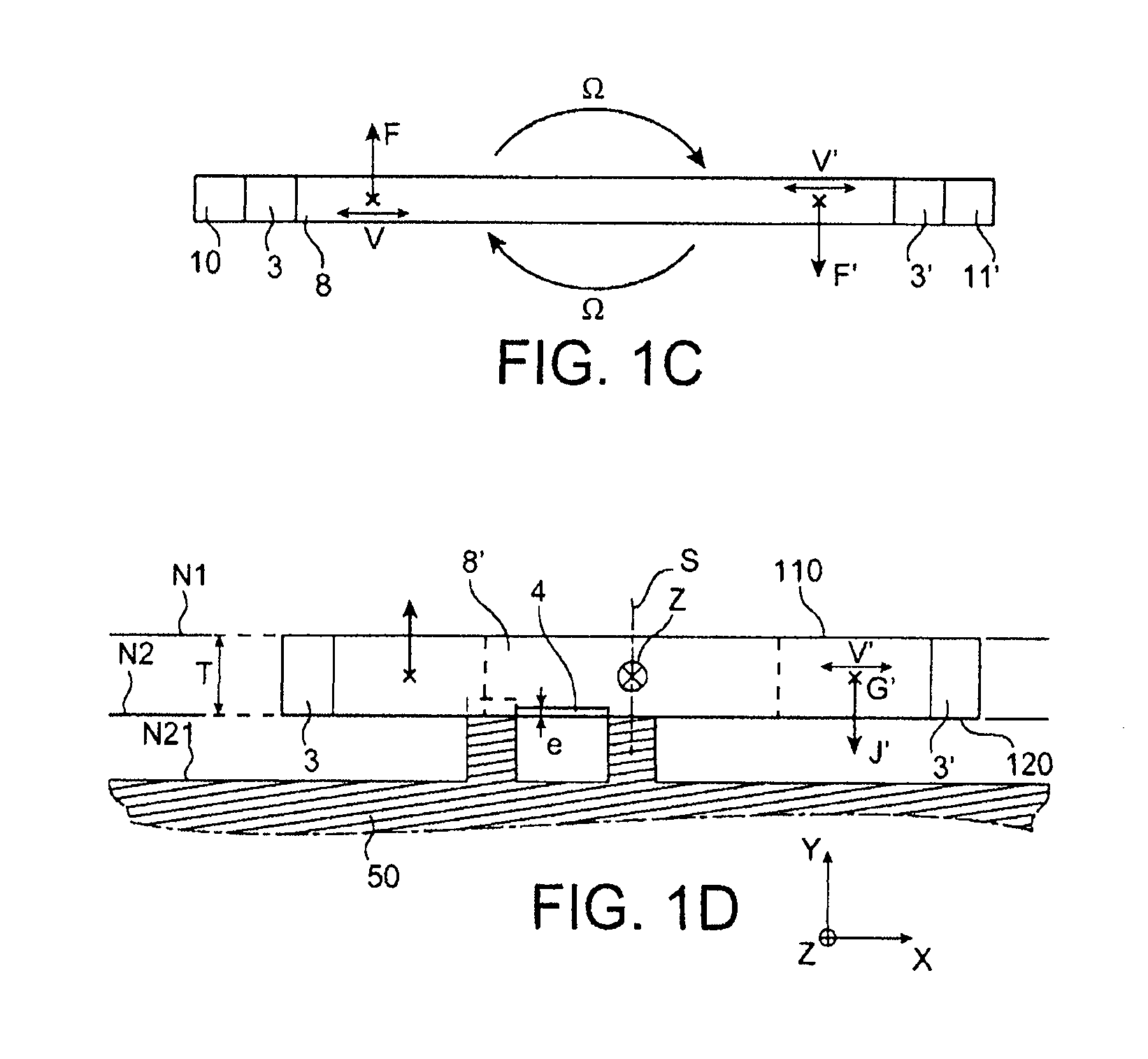Gyrometer in surface technology, with out-of-plane detection by strain gauge
a strain gauge and surface technology, applied in the field of microsensors, can solve the problem that the device is not able to detect rotation around an axis situated in its own plan
- Summary
- Abstract
- Description
- Claims
- Application Information
AI Technical Summary
Benefits of technology
Problems solved by technology
Method used
Image
Examples
first embodiment
[0055]the invention concerns a gyrometer-type device illustrated in FIG. 1A (top view) and 1B-1F (cross-sectional views).
[0056]It involves a gyrometer-type sensor resonating with gauges positioned so as to measure a rotation. This sensor is planar (plane XZ) and undergoes planar excitation in its plane. If the device is subjected to rotation around an axis Z, arranged in its plane, Coriolis forces drive it in rotation around this axis, but the movement J corresponding to this rotation is situated outside the plane of the sensor.
[0057]FIG. 1A shows that this sensor comprises an assembly of two masses 3, 3′ and an assembly of connecting arms 8, 8′, 19, 19′, 29, 29′, 190, 190′, 290, 290′. Idle, the arms and the masses are all situated in the plane of the device. Arms 8, 8′ are connected to zones 5, 5′ forming a pivot around an axis Z on which they are aligned. This axis is situated in the plane of two masses 3, 3′. It is the axis around which the movement J corresponding to a rotation ...
second embodiment
[0109]the invention will be described in connection with FIGS. 2A and 2B. It again concerns a sensor of the gyrometer type, of the same type as that of the previous embodiment, the differences being primarily related to the strain gauges.
[0110]In this embodiment, there are four strain gauges arranged differentially, two for each pivot zone or for each extension 81, 82 of each zone forming a pivot. The extension 82 and the pivot 5′ have the same relative arrangement, in relation to the arm 8, as the pivot 5 and the extension 81 in relation to the arm 8′. In the example illustrated in FIG. 2A, the two gauges 6, 6′ are directly applied to the extension zone 82 of the pivot 5′ for the upper primary arm 8. Each of these two gauges is also fixed to the substrate 50. A movement of the arm 8 therefore imposes a force on each of the gauges 6, 6′ in the plane of the sensor. These two gauges are arranged symmetrically to each other in relation to the plane S and in relation to the axis Z. Two ...
third embodiment
[0131]a device according to the invention is illustrated in front view in FIG. 3A.
[0132]This device, like the device described in the preceding embodiments of the invention, is made up of three zones. It has essentially the same dimensions as those indicated above, in thickness T, as well as in dimensions L and 1 in the plane XZ.
[0133]A first zone includes two masses 3 and 3′, symmetrical to each other in relation to a plane S perpendicular to the plane of the substrate. The intersection between this plane and the plane of the substrate forms an axis of direction Z. The axis X and the axis Y are defined as in the first embodiment. The thickness T of this first zone is between some 100 nm and some 10 μm, for example 1 μm.
[0134]The first zone contains the two masses as well as the primary connecting arms 80, 80′ and 81, 81′ oriented along the axis X and secondary arms 19, 19′, 190, 190′, 29, 29′, 290, 290′ oriented along the axis Z.
[0135]Each of the primary arms 80, 80′, 81, 81′ is el...
PUM
 Login to View More
Login to View More Abstract
Description
Claims
Application Information
 Login to View More
Login to View More - R&D
- Intellectual Property
- Life Sciences
- Materials
- Tech Scout
- Unparalleled Data Quality
- Higher Quality Content
- 60% Fewer Hallucinations
Browse by: Latest US Patents, China's latest patents, Technical Efficacy Thesaurus, Application Domain, Technology Topic, Popular Technical Reports.
© 2025 PatSnap. All rights reserved.Legal|Privacy policy|Modern Slavery Act Transparency Statement|Sitemap|About US| Contact US: help@patsnap.com



